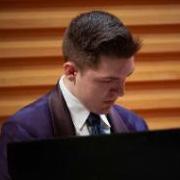All Activity
- Past hour
-
Hey @MK_Piano! Great ideas so far! I think what I find confusing about the beginning of your main theme (after the short 4 measure introduction), is that at first it seems like you start the piece on an accompanimental one measure vamp in the strings. So the phrase actually seems to start on measure 6 in the Bassoons. That serves as the antecedent phrase of a musical period. It lasts for 4 measures from bar 6 - 10. That's just fine and dandy, but then the consequent phrase doesn't come in until measure 11 in the Bassoons once again. So it seems like you might be including that one measure vamp again as part of the phrase, in which case it becomes an acephalic five measure phrase. I know Haydn and even sometimes Mozart were known for writing five measure phrases. I am not sure if it is working here. If you are happy with it - definitely keep it! But to me it would sound better if you concatenated the phrasing so that the consequent phrase would start at bar 10. This confusion about the phrase lengths continues into the 2nd iteration of the phrase at measure 18. The phrase starts right on beat one, so this time its not acephalic. But then it continues for five measures from measures 18 - 23 with a slight 3/4 hemiola that's then concatenated to terminate on beat one of measure 23. To me this definitely starts to sound awkward and confusing in the phrasing. When I first listened to the piece without looking at the score, it sounded like you changed meter to 3/4 and then abruptly back to 4/4. I felt lost as a listener, not knowing where the phrase was going rhythmically. So although kinda awesome, the piece does have many structural flaws that confuse (at least this) listener. When the piano comes in on the theme later on in the piece (solo), you do concatenate the phrases to 4 measure phrases and I think that does kinda work better. But I think as far as the big form and macro-tonal plan is concerned, the piece seems to repeat too much. I think if you had included the contrasting 2nd theme in the exposition before doing a 2nd exposition with the piano that would have made more sense. But I have personally never written a piano concerto in sonata form before - I've just written two theme and variations pieces for piano and orchestra. So all my experience is in concertante type piano concerto writing. Thanks for sharing and I hope some of what I had to say was helpful/useful!
-
Requiem pro mundo moriente
Churchcantor replied to BipolarComposer's topic in Orchestral and Large Ensemble
Cool! Have you ever studied the manuscript to see how much of it Mozart actually wrote? Only movement fully orchestrated by Mozart was the first movement, the Introitus. He got about halfway (Hostias/Quam Olim) with only vocal parts, figured bass, and suggestions of first violin figurations. I love it, but prefer to call it the Mozart/Süssmayr Requiem! Highly influenced by Michael Haydn's Requiem, and that one and even Salieri's are worth a listen. Start here: I like Costas Court Composer; he basically writes Haydn symphonies that sound like Haydn, middlin' Haydn anyway. Nice guy, and when I asked if he were Joseph Haydn, or Michael, in a past life, he thought it was pretty funny... -
Requiem pro mundo moriente
Alex Weidmann replied to BipolarComposer's topic in Orchestral and Large Ensemble
By sheer coincidence, I just went to a performance of Mozart's Requiem tonight! - Today
-
PeterthePapercomPoser started following WIP - First Piano Concerto (Feedback Wanted)
-
MK_Piano started following WIP - First Piano Concerto (Feedback Wanted)
-
Hey everyone. I have been going back and forth on my first piano concerto for a long time. Unfortunately, I reached a point where my original design has acted as a roadblock for me to finish the first movement. I decided to restart the work and compose from scratch. I will add more context below, however as an introduction, this excerpt is the entire exposition of my first draft. It is five minutes long and I wish to have it preserved here on YCF. So, sit back, and follow along to the work-in-progress of my first concerto! 🎹 ________________ CONTEXT AND FEEDBACK: I started this project back in June 2024 when I improvised the first theme in one of my practice sessions. I fell in love with it and immediately knew I found a theme worthy for a concerto. I am sticking to late classical (and possible romantic hints) for this work. Hummel, Shostakovich, and Rachmaninoff are the main three sources of inspiration for my orchestration. It follows Sonata-form, however using three themes (1st, 2nd and closing theme) in the exposition. Recently, as I have been diving heavily into the works of Mozart, Haydn and Beethoven, it has dawned on me the level of sophistication each composer had in their writing. How Beethoven would use elements of the first theme to make his second theme, and later use the first movement as basis for theme and variation writing or fugal writing in his third movements. So, after a break in the first half of the year, I have been looking at this exposition and tried to add sophistication. However, I noticed so many gaps in the structure. As it stands, it feels like a compilation of several themes versus one long work showcasing the transformation of the motif and form. As a result, I have stopped working on it and grabbed a blank manuscript and wrote down the key three themes I want to use. I have yet to start rewriting, as I want to give my brain a break and simply ask for feedback. I would appreciate comments on form, orchestration and anything you deem fit. Please do not hesitate to be blunt either! (I may try to write pure double exposition instead of this quasi-expo before the first piano cadenza.) Thanks in advance!! 🙂 _________ EDIT: There is no English Horn in this work so far. I used my Orchestral template and forgot to remove the English Horn from the instrumentation page. Also, The score is NOT TRANSPOSED; it is a concert score)
-
PeterthePapercomPoser started following Requiem in Bb major - Quam Olim II
-
Hey Guys, I hope you are doing well. I really like composers from the Romantic era, like Chopin or Liszt, and I wanted to create a piece of music in that style. Did I nail the feel, or not? Feel free to share what you think! Thanks!
-
- piano music
- romantic music
-
(and 2 more)
Tagged with:
-
therealAJGS started following back to reality
-
Good news! messing around with piano patterns make a good song! sorry about the quality... Mp3s just aren't that good.
-
Concert performance of my piece for harpsichord
Alex Weidmann replied to Alex Weidmann's topic in Piano Music, Solo Keyboard
Thanks Vince! Heres the programme note I wrote for the concert: My journey into composition began in 2022, guided by a lifelong admiration for Bach and the intricate elegance of the Baroque era. That gravitational pull toward counterpoint and ornamentation shaped the earliest incarnation of this piece: a three-movement work blending electronic synths with orchestral textures, piano, harpsichord, and SATB choir. It was a fusion of old and new, structure and shimmer. Since then, the piece has evolved through several arrangements, each a recalibration of its emotional and sonic architecture. This latest version distills the work into two movements for solo harpsichord, shedding layers while introducing new material that reframes its core motifs. The intention is simple yet vivid: to evoke the image of a sun-dappled forest, where light filters through leaves in shifting patterns, and time feels suspended in golden stillness. I hope the music invites you into that space. N.B. I gave the third movement to the harpsichordist; but she told me it was unplayable: so it wasn't performed. I'm very happy with her interpretation of the other two movements. She played them slower than the tempo I'd imagined; but I think it suited the music very well. -
decided to go back to my first ever song, when I just got FL studio. this was actually made early 2024, but I joined this platform later.
-
PeterthePapercomPoser started following Arrangement for Piano Sonata in C major by Joseph Haydn
-
No hurry! 🙂
-

2025 Halloween Satisfaction Survey
HoYin Cheung replied to PeterthePapercomPoser's topic in Monthly Competitions
Overall speaking, I quite enjoy the format and atmosphere of this competition. I think the judging mechanism of this competition is good as, 1) Variety of awards/ scoring criteria - It gives recognition to the composers for certain aspects of his music, and allows (specifically growing composers) much specific target/ direction to enhance. Moreover, appreciation to "good" music in some cases where the music is not fitting to the given theme, but is still pleasant to listen to. 2) Qualitative - Please keep the scoring template optional. IMO the scoring template is a benchmark to distinguish the relative performance of each entrants - while the scoring scale may be inconsistent between different judges (i.e. non-linear and subjective), at least that serves as a tool to establish consensus between different judges the rank of each entrants. -
Henry Ng Tsz Kiu started following Arrangement for Piano Sonata in C major by Joseph Haydn
-
Kvothe started following 2025 Halloween Satisfaction Survey
-

2025 Halloween Satisfaction Survey
Kvothe replied to PeterthePapercomPoser's topic in Monthly Competitions
Hello everyone! My thoughts about the Halloween competition: 1. The scoring sheet help to me to scored each entries as I review them impartially. 2. I think it will be those who are new to grow. 3. There are so many entries, including me, that wrote in different styles. I think if we had a competition that highlight these styles it push members to write new styles. 4. Maybe we can one in the future that monetary reward. But now? 5. For now, let us keep for fun until members mature enough to do official ones. (Even on here) -
HoYin Cheung started following Arrangement for Piano Sonata in C major by Joseph Haydn
-
Hi all, As some of you may know, I am actively engaging in my composition project for differential festivals. For that reason, I want to adapt into different types of music and add more variety in my project. I chose arranging solo piece to orchestal music to 1) appreciate the style of the composer, and 2) hopefully benefit orchestral work listeners/ writers. Work orchestrated in this post: Piano Sonata in C major, Hob. XVI/50, L.60 Written c. 1794 by Joseph Haydn. This first movement - Allegro, was arranged by me. When I have time, I will share other movement. A side note, I only listened to the piano recording once before I decided to arrange it - perhaps it is a good thing in the sense that I got my interpretation different from pre-existing pianists Thank you for listening! Note: Attached original score for reference. HoYin
-
Nostalgic vibe there. Do you think of the harmony first or melody?
-
PeterthePapercomPoser started following Romance Vocalise in C Minor for Soprano and Piano and Prelude no.13
-
Well, it's no big problem, but sometimes you "drag" your cadences! I'll try to find an example, but making spaghetti sauce right now; maybe in the morning.
-
Would you be willing to elaborate on this point? (meaning, if you would, explain your thoughts on this, by quoting bar numbers or specific phrases where I could improve upon this idea?)
-
Now that you mention it, I can see where I got a bit zealous in the writing as it pertains to what the playback sounded like 😅 And since it was a while ago that I actually wrote this score, I didn't change much from how I had it originally. I may go back and rework those sections now that you say that, because I would happen to agree with those notions. Thanks for your feedback Henry! It's always appreciated 🙂
-
Thank you thank you ❤️ I may post periodic updates as things progress, especially if I find myself lost on where to go. That tends to happen quite often.. lol but since I do this on my down time, It helps to be forced to take breaks from writing, on a consistent basis, so I have to go deaf to what I wrote a few hours ago. That helps come back at it fresh again. But right now, I'm struggling with how to progress the cello section, into a transition towards an A' or B' section again...
-
I'm ashamed to admit I did the same 🥶 I did read this though, promise 😄 This was actually one of the most interesting pieces you've written to me. I know you've written lots of music where you had to think much harder, or it's magnitude is superior (where them ff variations), but this was cool because you've imposed self-restrictions with the notes and avenues you're allowed to go. I think as you've done these your intentions have become much more clear and refined from what I remember of the others, and representing the abstract is a path you've become really good at. It's kind of serial music, right? Predetermined notes and instruments, but your composing intentions are all your own. I didn't like the ending at first, but as I listened more it felt charming and worked really nicely. Well done, Peter!
-
.thumb.png.8b5b433a341551e913a34392660bc95b.png)
2025 Halloween Satisfaction Survey
PeterthePapercomPoser replied to PeterthePapercomPoser's topic in Monthly Competitions
In all the years past, the Christmas Event was just an event - not a competition. It was a completely free event with no limitations on ensemble nor duration and no judges, or scoring. The intent was just to channel the spirit of Christmas (or the holidays or winter) in the music in any way the participants saw fit. And there were only two types of badges - participant badges for everyone who submits music and community organizer for whoever bolstered the event through an announcement post and submissions thread. There was never any popular voting or anything like that either. Sure, that's a great idea! Let me know what you think of the Category Definitions in the Competition Reviewing Template that I just added! Thanks for your input! - Yesterday
-

Concert performance of my piece for harpsichord
Thatguy v2.0 replied to Alex Weidmann's topic in Piano Music, Solo Keyboard
I remember when you posted this piece while working on it. It's come a long way, congrats on the performance! -
Yeah, and I think in general you could apply this throughout. Majestic is the right word, and you capture that so well. Some movement in the chords later on would be good to keep your music driving while remaining at a slower tempo. I really like that moment with the cello at bar 38. The color in your music is wonderful as usual!
-
Hello there! Before, I had the project in mind of writing 12 piano preludes, and that was just dandy. I don't know how consecutively I'll write more, but a few ideas have lingered lately so I figured I would dabble at it again. Here's a very short one in C, hope you enjoy!
- 1 reply
-
- 1
-



.thumb.png.1e2763f479362bbb522da50d31ef2e50.png)
